Spain Plus Two Cities in 2022, Marseille
Parts
Monday, October 10
My train arrived in Marseille around 21:30, so all I did was go to my hotel and
unpack. Happily, this was another hotel near the train station, just across the
street.
Tuesday, October 11
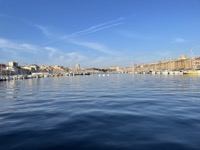 |
| Vieux Port. |
 |
| Vieux Port. |
I got something of an early start, went to the metro station below the train
station, bought a 72-hour pass, and rode the subway to Vieux Port, took a few
photos, got oriented, asked the tourist office about options, and set off to
walk through the oldest district of Marseille, Le Panier. There I tried to
figure out what was on exhibit and where at Le Vieille Charité, a
former almshouse now used for museums and other educational and cultural
activities. The courtyard is surrounded by multiple buildings with multiple
interior spaces on multiple floors, and it took me a while to find their Museum
of Art of Africa, Oceania, and Amerindia and make my way around.
 |
| Scene in Marseille. |
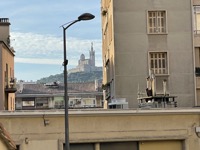 |
| Scene in Marseille. |
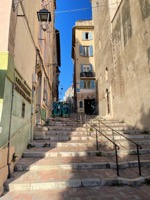 |
| Scene in Marseille. |
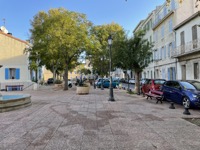 |
| Scene in Marseille. |
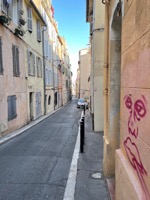 |
| Scene in Marseille. |
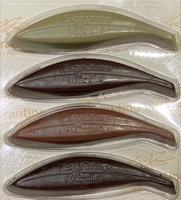 |
| L’Espérantine de Marseille. |
 |
| L’Espérantine de Marseille. |
After that, chocolate stores were open, so I went to L’Espérantine de
Marseille, still in Le Panier. Their “thing” is chocolate with infused olive
oil. I tried that and their solid chocolates. Some of the latter, I discarded
uneaten, so that is a no. If you want to try the olive oil with chocolate, Chocolate Therapy in
Framingham, Massachusetts, has a nicer olive-oil piece.
Then I walked around getting acquainted with the area around Vieux Port and
also visited about six more chocolate stores or places were there had been
chocolate stores. Even though some were gone, Marseille had plenty of chocolate
stores—too many for me to sample. I did buy some at Le Temps d’un Chocolat,
pictured below.
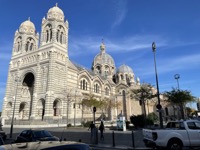 |
| Cathédrale Sainte-Marie-Majeure de Marseille. |
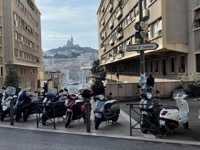 |
| Scene in Marseille. |
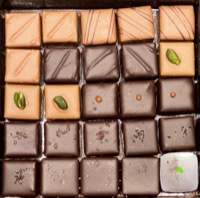 |
| Le Temps d’un Chocolat. |
Next I visited Basilique Notre Dame de la Garde, another church on a hill. Take
a look at the last photograph of the set below. The signs say the wall bears
the marks of the battle of the liberation of Marseille, August 15-25, 1944.
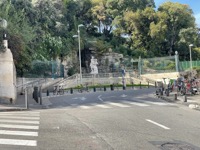 |
| Near Basilique Notre Dame de la Garde. |
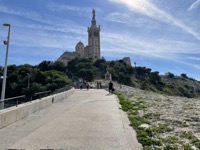 |
| Basilique Notre Dame de la Garde. |
 |
| Marseille from Basilique Notre Dame de la Garde. |
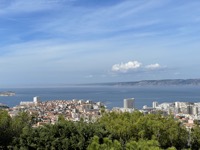 |
| Marseille from Basilique Notre Dame de la Garde. |
 |
| Marseille from Basilique Notre Dame de la Garde. |
 |
| Marseille from Basilique Notre Dame de la Garde. |
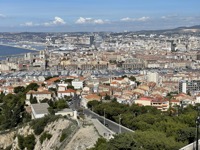 |
| Marseille from Basilique Notre Dame de la Garde. |
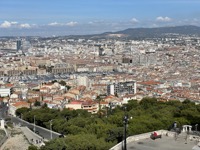 |
| Marseille from Basilique Notre Dame de la Garde. |
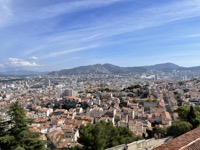 |
| Marseille from Basilique Notre Dame de la Garde. |
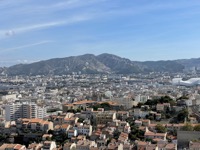 |
| Marseille from Basilique Notre Dame de la Garde. What are the terraced slopes in the background? |
 |
| Wall of Basilique Notre Dame de la Garde. |
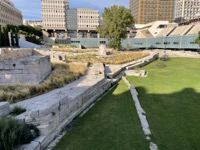 |
| Marseille history. |
 |
| Marseille history. |
After checking out a few chocolate stores in the area, I took a bus to Musée
d’Art Contemporain. Unfortunately, it was closed for renovation. I caught the
bus back, and it took a detour due to construction or something, and I did not
know where it was going. Without technology, that could be a problem, having to
figure out where you are unexpectedly. Fortunately, my iPad helped me keep
track, and I signaled for a stop near a metro station and changed to the train.
It is harder for them to detour that.
Does anybody rate metro systems for loudness, smoothness, and speed?
Marseille’s trains seemed fast but were pretty loud.
Back at Vieux Port, I found a croissant. The Spanish hotels had croissants at
breakfast, but they were somewhat bread in a croissant shape, and I hoped for
something buttery and flaky. A croissant at L’Atelier des Pains was nice but
not great. Maybe I will find a recipe and try it on my own.
Wandering around some more, I found the Ancient Port, a few hundred meters
inland from the Vieux Port (Old Port). The grass in the photos at the right is
where the water used to be. They found the Ancient Port while excavating for a
new mall. I will get back to this in Wednesday’s notes, when I visited the
museum inside.
Wednesday, October 12
I started the day at Musée des Civilisations de l’Europe et de la Méditerranée
(MUCEM), which Lonely Planet called fantastic and stunning. I found it
disjointed, shallow at points, and promoting viewpoints about the Mediterranean
diet and power and trade in the Mediterranean. Not that its viewpoints were
necessarily misguided or wrong, but some of the claims made lacked explanation
or support. The exhibits leaned away from museum presentation of facts toward
advocacy.
The museum is connected by a footbridge to Fort Saint-Jean, where there is a
much more modest but more interesting presentation about the history of the
fort, covering its two-thousand years of existence and use by different people
at different times.
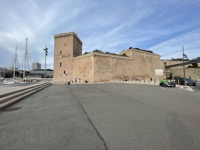 |
| Fort Saint-Jean. |
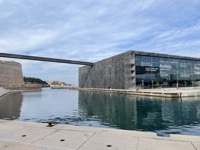 |
| MUCEM. |
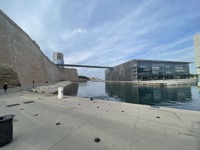 |
| MUCEM. |
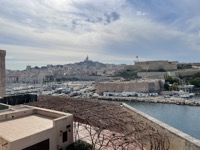 |
| View from Fort Saint-Jean. |
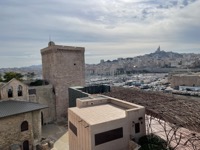 |
| View from Fort Saint-Jean. |
 |
| View from Fort Saint-Jean. |
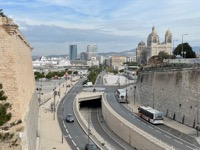 |
| View from Fort Saint-Jean. |
I made a sweep of the Musée Regards de Provence, a private art museum with a
memorial to the Station Sanitaire that used to be in its place, and headed to
Musée d’Histoire de Marseille at the Ancient Port. Below are more pictures of
the port, which dates from the first century CE. It was filled in after the
sixth century CE. They can tell from traces of barnacles and marine corrosion
that the sea level was 50 cm lower than the current level.
The adjacent museum has ships that were found buried at the port. The walkway
leading to the stairs in the photos below used to be the entrance to the city
from the port. The different types of stones and layouts in it were put in in
different eras.
 |
| Ancient Port. |
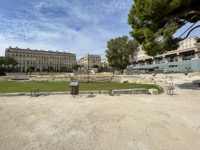 |
| Ancient Port. |
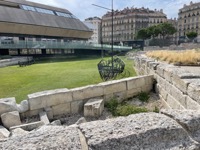 |
| Ancient Port. |
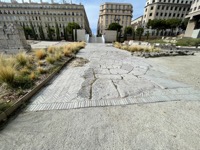 |
| Ancient Port, different pavings from different eras. |
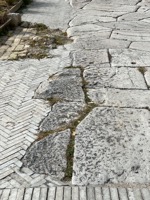 |
| Ancient Port, different pavings from different eras. |
 |
| Ancient Port, different pavings from different eras. |
The tourist-trap restaurants around Vieux Port were largely unappealing to me,
so I settled for a salad place. Then I visited Musée Cantini, which had
an exhibit of the works of Maria Helena
Viera da Silva, an abstract artist. With a few of her works, the museum
displayed quotes from her about the work. With others, the museum had its own
text. The artist’s quotes made sense about what the accompanying painting was
portraying, whereas the museum text generally rambled into nonsense.
 |
| Les Fèves Toquées. |
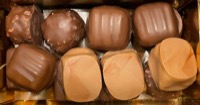 |
| Hubert. |
Leaving the museum, I resumed my chocolate hunt, finding three more closed
stores and one that had changed its name. That one, Comptoir Marlau or Les
Fèves Toqées, is a specialty food store with chocolates. They retail several
brands of different qualities, not all labeled in the case, so you have to know
what is what to select the good stuff. After that was Maison Hubert, which presents as a family
business but has some pieces that look suspiciously like Michel Cluizel products.
Then I visited Cours Julien the center of “Marseille’s most vibrant bohemian
quarter” according to Lonely Planet.
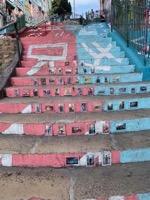 |
| Street art near Cours Julien. |
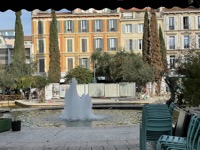 |
| Cours Julien. |
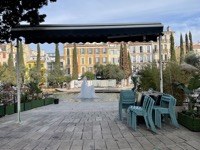 |
| Cours Julien. |
 |
| View from Cours Julien. |
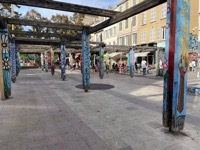 |
| Cours Julien. |
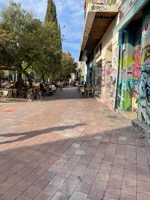 |
| Cours Julien. |
Proceeding to Palais
Longchamp, I visited Musée
des Beaux Arts in its east wing. One of the first things I saw there was an
1843 painting that looked pretty good for its time and age, Vue prise sur le
chemin de la Maladetta (View taken on the path to the Maladetta) by
Jean-Baptiste Dalige. It has some good color and sparkle. I could not get a
good photo, but you can see a low-resolution image here.
I also noticed Le Choléra à bord de la Melpomène by Horace Vernet
because it was one of the few paintings not of some wealthy or powerful people
or a religious story. The sign with it provides another example of machine
translation.
That wrapped up my day.
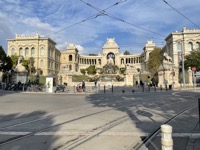 |
| Palais Longchamp. |
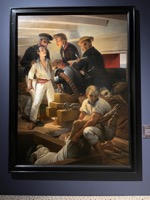 |
| Le Choléra à bord de la Melpomène at Musée des Beaux Arts. |
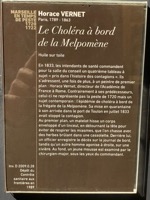 |
| Sign for Le Choléra à bord de la Melpomène. |
 |
| Translated sign. |
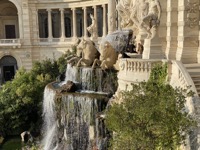 |
| Palais Longchamp. |
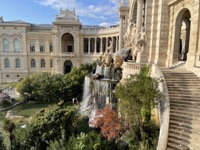 |
| Palais Longchamp. |
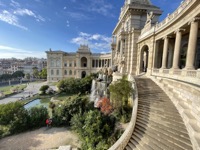 |
| Palais Longchamp. |
 |
| Palais Longchamp. |
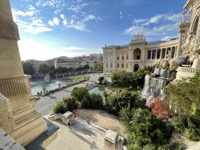 |
| Palais Longchamp. |
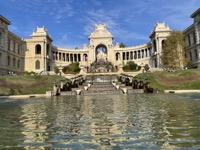 |
| Palais Longchamp. |
Thursday, October 13
Thursday I had finished my primary Marseille checklist, so I did secondary and
tertiary things. While waiting for stores to open, I noticed several people
arriving on scooters, which seemed to be in common, but not heavy, use in
Marseille. I did some quick window shopping at Les Docks Village and then
headed to the mall across the street, where I got you a photo of an Apple Store
with a boat behind it and a Reservoir advertising their crashed computer.
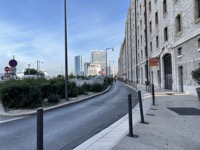 |
| View at Rue des Docks. |
 |
| Scooters and bicycles. |
 |
| Apple Store in Marseille. |
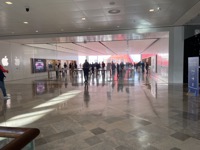 |
| Apple Store in Marseille. |
 |
| Crashed display. |
Wandering around, I happened across Labstyle, a “concept store” with home decor
and whatnot but also a sign out front advertising Michel Cluizel chocolates.
Then I headed for Palais du Pharo, which Napolean had built for Empress Eugenie.
 |
| View in Marseille. |
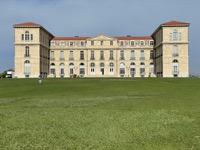 |
| Palais du Pharo. |
 |
| View from Jardin du Pharo. |
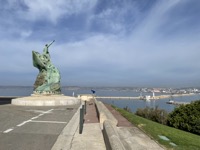 |
| View from Jardin du Pharo. |
 |
| View from Jardin du Pharo. |
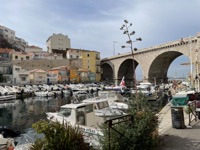 |
| Vallon des Auffes. |
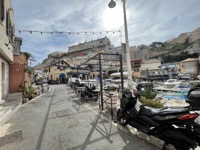 |
| Vallon des Auffes. |
Then I went to Vallon
des Auffes, a “traditional fishing haven” with an overpriced pizza
restaurant. I headed back toward the center of town to check out a café I had
seen from the bus the day before that seemed popular. But its menu was
unimpressive. It may just have been a business lunch crowd looking for
convenience and burgers.
Back at the Vieux Port area, I searched high and low for a tuna crêpe. They
are easy to find in Paris, but not so here. After checking several crêperies
and walking a fair distance, I settled on Poké at Pokawa. it was fairly nice,
but still not quite as good as I have had in the US.
After leaving Pokawa, I passed a little place with a tuna crêpe on its menu.
 |
| Pokawa poké. |
Friday, October 14
Friday was a long train day (seven hours) that had been giving me anxiety since
buying tickets. When planning this trip, I found a train route from Marseille
to Zürich with a 34-minute transfer in Dijon. When I went to book it, the
computer changed it to a route with the same start and end times but an
eleven-minute transfer in Mulhouse. I tried the French train company, the Swiss
train company, and a third-party web site, and they all made that substitution,
even if I set the option to have transfers of at least 30 minutes. So I booked
the ticket and figured I would try to change it in Europe.
At home, I used Google Maps to investigate the Mulhouse train station, inside
and out. It was a simple layout, eight parallel tracks connected by an overhead
bridge, and Google Maps had interior views that showed where the departure
displays were. So I was prepared to make a quick transfer.
In Spain, the folks at a Renfe counter said they could not change the Swiss
ticket. When I finally got to Marseille, the advance-purchase discounts were no
longer available, and the price change would be prohibitive. (European train
tickets are often much cheaper when booked in advance.)
So, I kept the original ticket and kept a close watch on the progress of both
trains. Shortly after leaving Marseille, my train was five minutes late. After
a few stops, it seemed to make up for it, but then it became five minutes late
again. The Lyon stop was scheduled for ten minutes, so I hoped they could just
shorten that to five and depart at the scheduled time, but no.
That continued until we were approaching Mulhouse. The Swiss train company app
said my second train was on time, so I was expecting to have six minutes for
the transfer. Then I noticed the app was showing me a train number different
from that of my ticket. Checking more carefully, it showed two trains with
different numbers both scheduled to go from Mulhouse to Zürich with the same
departure and arrival times. As it turned out, they were trains that started
separately and joined at some point. But the app showed one was ten minutes
late and the other was on time.
Eventually, my train arrived at Mulhouse four minutes late. I hustled along
the platform, up the stairs, and looked for my next train. The displays were
there, but each showed information only for the track it was by. So I had to
walk to one end of the bridge and then back, and then I made it to my platform
on time.
The two connected trains arrived at the station at the same time, in spite of
the app. So, I made my connection, and then there was some holdup approaching
Zürich, so the train arrived 30 minutes late.
© Copyright 2022 by
Eric Postpischil.




























































